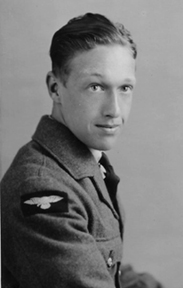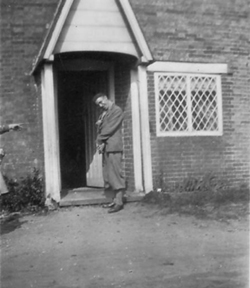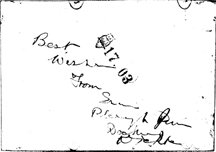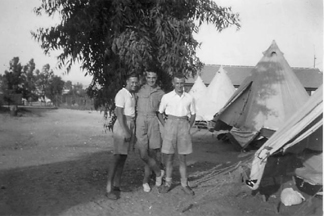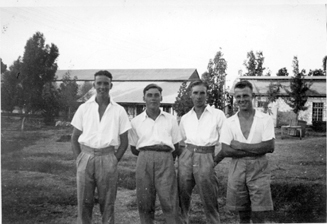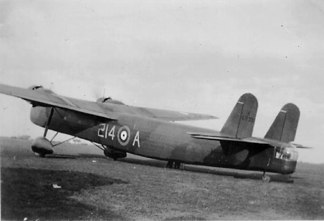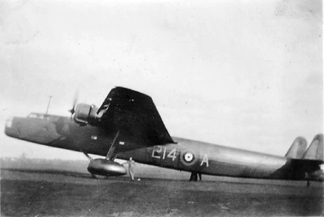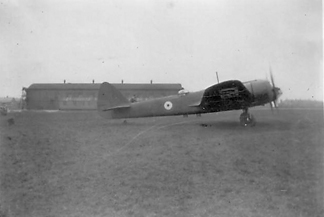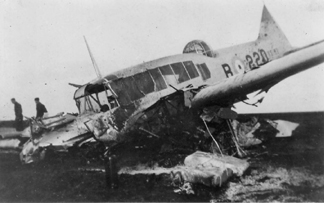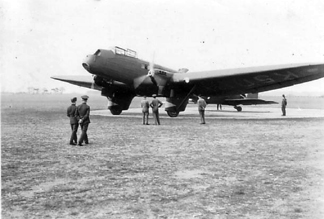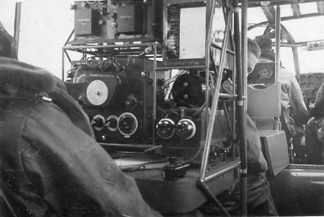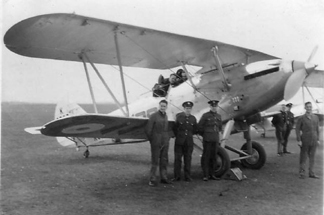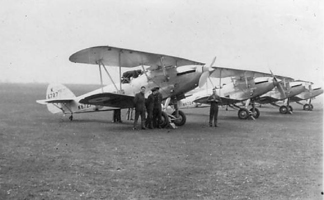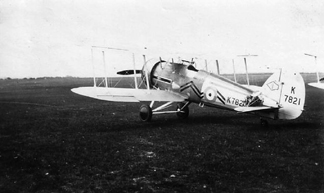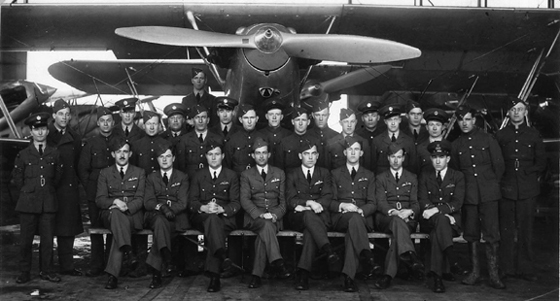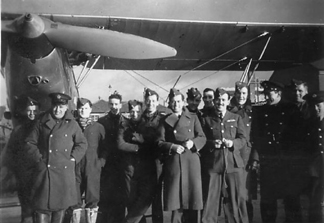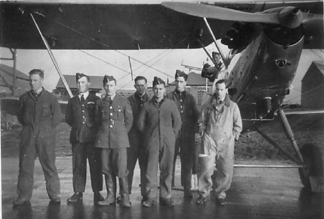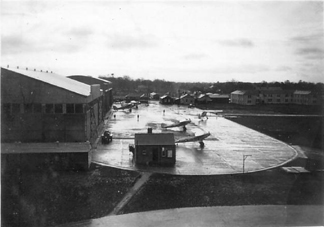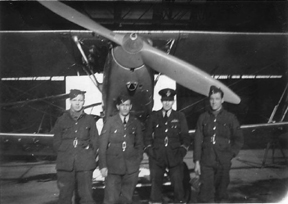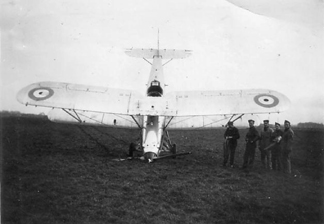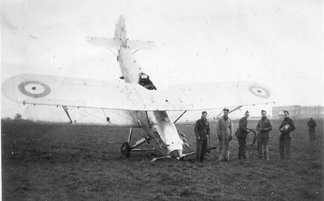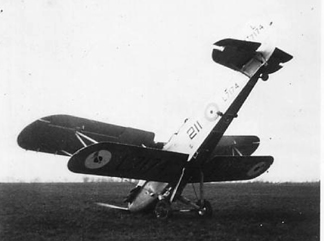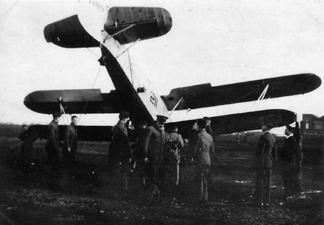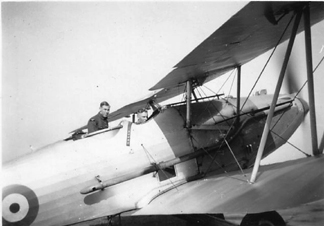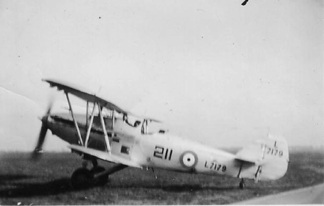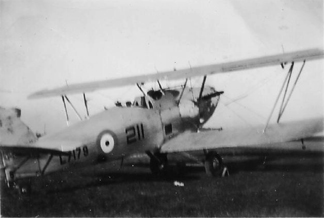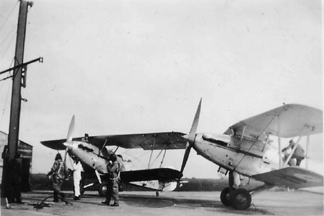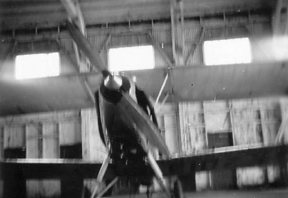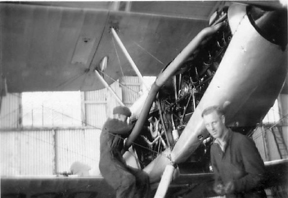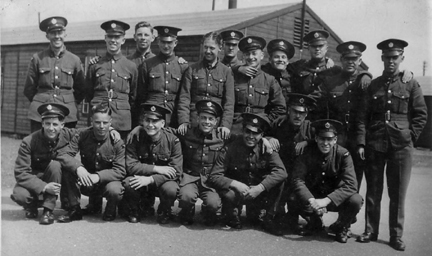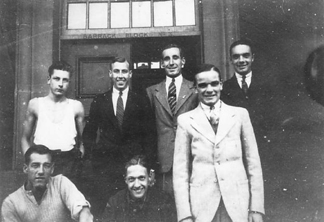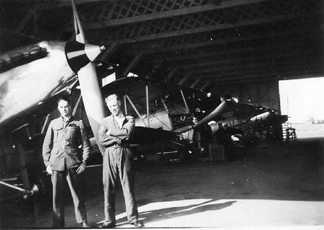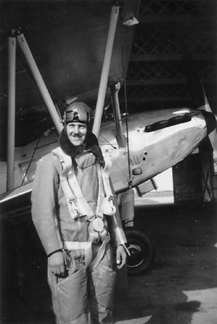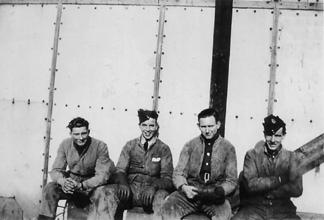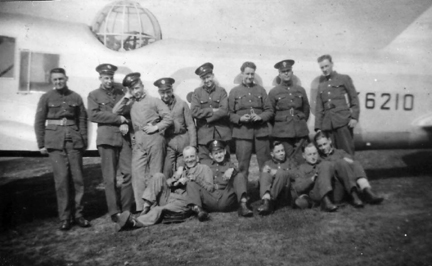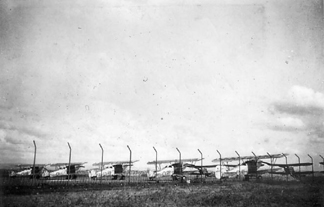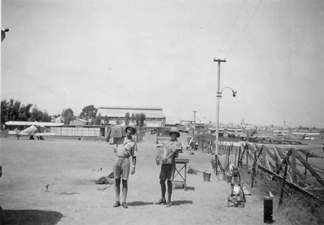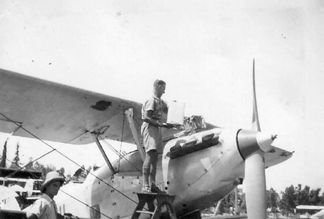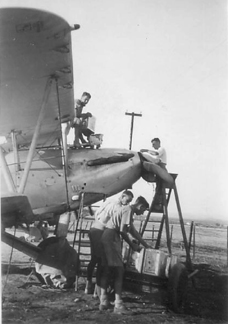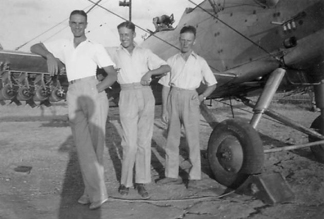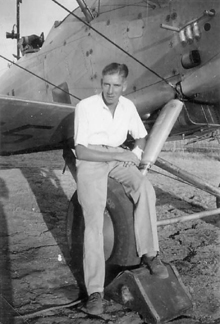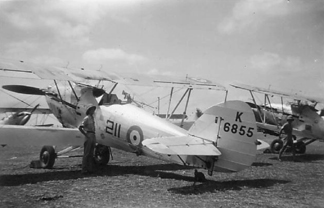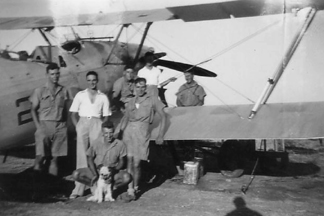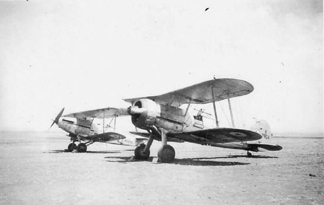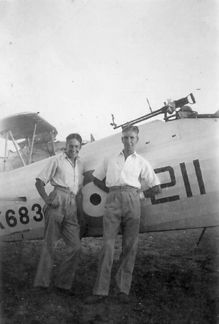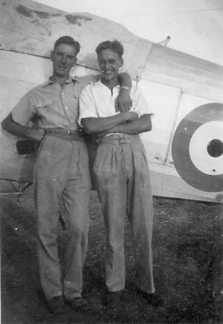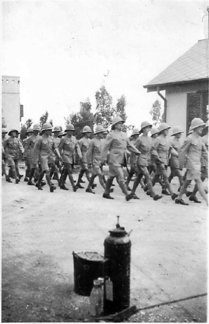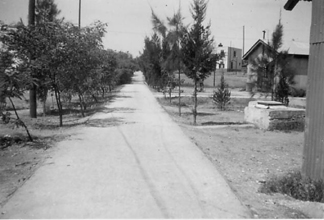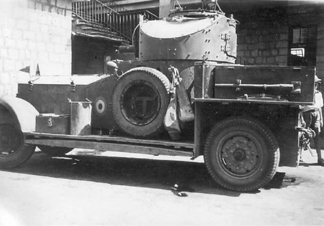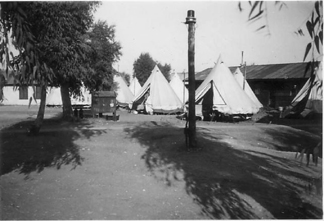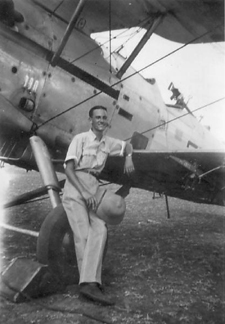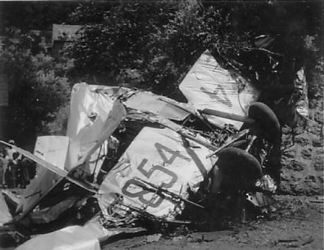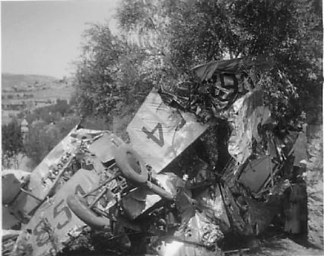 |
 |
||||||||||||||||||||||||||||||||||||||||||||||||||||||
|
An airman’s album After learning that Hawker Hind L7181 of 211 Squadron was under restoration in the United Kingdom by Guy Black’s RetroTec for his Historic Aircraft Collection, he, Pat Chriswick and I kept up an occasional correspondence on matters Hind. It was with considerable surprise and delight when I heard from Guy in 2004, about a very remarkable find. Along with his aviation and aircraft restoration interests goes an interest in vintage cars. So it was that, tiring towards the end of a day on the lookout for likely bits and pieces at a very large auto-jumble, Guy took a few moments rest at a stall by idly leafing through a pile of old car magazines. And there it was: “...right at the bottom...6 or 7 leaves from a photo album containing all these pictures; of course the most exciting discovery being the pictures of L7181”. Nothing about the album pages identified the original owner/photographer. However, a few of the photographs bore some brief notes on the rear. These, with the photographs themselves, were enough to identify the original holder as an airman of 211 Squadron, possibly one of the skilled groundcrew who had also qualified for the Air Gunner’s winged bullet. For example, Gunner LAC Geoff Grierson had himself flown in L7181 while still in the UK.
The sole formal portrait. Though it bears no notes, surely the album’s original owner. He seems to have served (or trained) briefly with 220 Squadron at Bircham Newton, before joining 211 Squadron, apparently to Aldergrove in 1938 and certainly on to the Middle East, at Helwan and at Ramleh. There he certainly knew Grierson, as they share many similar shots in their albums, including one or two of each other. On a handful of shots there are quite clear notes, all in the same hand. At first the writing seemed to be that of the unknown airman, but it turns out that the photos were those of another 211 Squadron airman altogether, the clowning “Ernie”. However, the notes have contributed to solving the puzzle of the four Australians who arrived at the very re-forming of 211 Squadron in the summer of 1937, over 80 years ago. I’ve used what information there was on the photographs, adding some name detail from the Air Force List, and seeking out additional details from other 211 Squadron collections or other published sources. In a few indicated cases the captions are from the album, otherwise of my choosing. Here, then, is the album of this unknown airman, with thanks to Guy Black. “Ernie” and the unknown airman
Dressed to kill in plus fours, and possibly in black-face, but in a quintessentially English setting. Just out of shot, left, someone is killing themselves laughing. The one clue to this airman’s identity is the rear of the photo:
Is that what it says? or is it “Best wishes from Ernie, playing...”. And is that a reference to Dorking? There is little to go on here, except that all the photos with titling were written by the same man.
The pleasant grounds of the permanent Ramleh camp, but still with tentlines for the airmen. The original titling on the rear is in the same writing as that of “Ernie”, above. Jenks: very possibly AC Jenkins of the larger of the two informal group shots at Aldergrove, below. Self: apparently the clowning “Ernie”. See below.
The clincher. This photograph is from Geoff Grierson’s collection. Third from the left, clearly the unknown airman. Fourth from the left, the same man as “self” above, whose writing appears on all the unknown airman’s shots, including “Best wishes from Ernie”. These two men are mates and it seems that Ernie gave the unknown airman a number of his 211 Squadron photographs. That which hath wings...
This particular aircraft is a Mark I, without mid-upper turret, delivered to 214 Squadron in early February 1937. The Harrows were introduced to RAF service from January 1937, starting with 214 Squadron at Feltwell. Accepted under specification B.29/35 as an interim bomber trainer and transport, 100 aircraft had been constructed by the end of 1937 and delivered to five RAF squadrons that served exclusively at Home. Later taking on varied transport and training roles, some remained in service until as late as 1945. Armourer JE Fryatt’s collection includes a fine aerial shot of a flight of Harrows, from 215 Squadron.
The lighting, sun-angle, personnel placement and idling engines make it clear that this is the same occasion, and the same aircraft. Cloudy-bright, as the film pamphlet used to say. Sometime between 4 February 1937 and 23 September 1937 (when K6938 went to 75 Squadron).
A rather faded and somewhat soft shot of a rather anonymous Mark I on a dull day. Turret retracted and apparently gunless, and without a Squadron no, the aircraft identity can only be partly resolved as K7nnn. This would place it as one of the first batch of 150 aircraft, delivered between January 1937 and January 1938, and quite possibly an early delivery, possibly at Grantham from hangar and other building details.
The aircraft identity is quite certain, from the Squadron markings and rather faint serial, which exactly match a detailed entry in J Halley’s wonderful Air Britain K File: RAF Aircraft of the 1930s. Delivered to 220 Squadron on 2 September 1936, K6199 ‘B’ crashed with one fatality at Bircham Newton on 9 November 1936, having stalled after taking off with the controls locked. Reduced to instructional airframe status (serial 959M) by 9 December, the machine remained as a salutary reminder of the need for care in pre-flight checks until struck off charge in August 1937. The original of this shot is of slightly different character and at 5¼in x 3½in, larger than the little 3½in by 2½in Velox prints that make up the bulk of the album. Possibly an official handout, for the reasons stated. LAC G Grierson kept a different and very battered shot of this event.
The hapless Hendon was the first “all-metal” (fabric covered) monoplane to enter RAF service. Designed to Specification B.19/27, and first flying in late 1930, just 14 production aircraft were eventually ordered under Spec 20/34 to finally begin RAF service in November 1936 with 38 Squadron. Certainly K50nn: in the dull light possibly K5087. The interest being shown suggests an early date, as does the apparently still-open front gunner’s position. Operational aircraft were fitted with with a glazed nose turret as well as the fully-glazed cockpit evident here. No 38 Squadron were the only RAF unit fully equipped with Hendons, retaining some until as late as January 1939.
A familiar scene for embryo RAF aircrew: Wireless Operator training at the radio stations in the cabin of an Avro Anson: perhaps of 220 Squadron.
Re-forming at Upper Heyford in January 1937, 108 Squadron were immediately equipped with Hinds, before moving to Farnborough in February and to Cranfield in July that year. A quite overcast day. The Squadron no is just visible above the starboard lower wing, while the serial is just cut off by it. At least one other Hind partly visible to the rear. Old-style uniforms still in use. This leading aircraft is, with virtual certainty, K6727: see below.
Clearly this flight of Hinds was taken on the same occasion, from the state and angle of the daylight and the positions of the aircrew and groundcrew. As well, here the aircraft serials are clear for the two leading aircraft, K6726 leading and K6724 to the rear. Both were delivered to 108 Squadron in the first week of March 1937 and remained with the Squadron until the end of June 1938. The Flight detachment from 211 Squadron Flight to Aldergrove was tasked to fly Air Gunners under training at the Armament Training Camp being held there. Perhaps this is a link in the story: the Anson photo above also indicates WOp/AG training. Possibly, then, these two Hind shots may be at Aldergrove in January 1938.
The aircraft shown here, K7821, was a Mark II delivered to 17 Squadron in early October 1936, when the Squadron was stationed at RAF Kenley. The much-liked Gauntlet was the last of the RAF open-cockpit biplane fighters. In the press of pre-war development, it was also the first aircraft in the world to achieve a radar-controlled interception, by GCI vectoring, in the 1937 experiment involving Bawdsey Manor experimental installation, 32 Squadron aircraft and a civil airliner approaching the Thames from the North Sea. Predecessor to the Gloster Gladiator, some RAF Gauntlets saw service (and combat) in the Middle East. Aldergrove, January 1938
In 1938, 211 Squadron was based at Grantham, as the Operations Record Book and other sources record. Still, LAC G Grierson’s flights and photographs had already shown that a Flight was detached to serve at RAF Aldergrove in Northern Ireland at some point in early 1938. The Operations Record Book for December 1937 confirmed the detachment, for most of the month of January. Here we see the strength of that Flight in an official shot. Although the print carries no description, other prints from the album (with help from Geoff Grierson’s collection and the RAAF Museum Pt Cook) make it possible to firmly identify the front row of officer pilots: P/O GR Magill, P/O GO Mills, P/O DG Boehm*, F/Lt EM Withy, P/O DA Cameron*, unknown, Acting P/O RA Couchman, P/O AL Farrington*. Withy, posted to the Squadron on 27 October 1937, had promptly been made up to Acting Flight Lieutenant and put in command of ‘B’ Flight. Three of the Australian Pilot Officers are present (*). Of the airmen in the back row, Flight Sergeant Thorne stands on the far left, and Corporal Barnes is sixth from the left. About half the airmen still wear the old-style tunic and service cap. The aircraft is a Hind. I’ve marked this as of Guy’s collection as a courtesy, though it must be an official shot.
Placed, dated and named in the same hand as the clowning “Ernie”, as explained above. This happy ‘B’ Flight group was caught on a cold but sunny winter’s day. From left to right: AC Cox, Cpl Barnes, P/O GO Mills, Waghorn, Jenkins, Goodeve, F/Lt EM Withy, Collison, Martin, P/O Magill, P/O JH WIlliams, P/O AL Farrington, A/C Long, F/Sgt Thorne. As an LAC WOp/AG in the early Blenheim days of the Western Desert, Goodeve flew twice with Squadron CO Gordon-Finlayson between October and December 1939, and on several operations in 1940, only leaving the Squadron in February 1941 to undertake pilot training.
As dated and named by “Ernie”: Sutton, P/O DA Cameron, Cpl Wright, AC Wood, AC Cox, AC Malyon, Acting P/O RA Couchman, in kite AC Marshall.
No original caption, but from its place in the sequence it seemed very likely to be Aldergrove, on a suitably wintry day. Mike Grierson confirmed the placement, unprompted. He spent a lot of time there flying Hercules, and returned for a visit last year.
The only identification, but clearly Corporal Wright (left) and P/O AL Farrington (right, in RAAF blue), flanked by two unidentified airmen.
Three shots of L7174 in an embarrassing position. Not difficult to do in these aircraft on a grass field, but not difficult to recover and repair either. The accident is unremarked in Air Britain’s RAF Aircraft L1000-N999. One of the first group of Hinds allocated to 211 Squadron, the aircraft went on to serve as a hack in various Communication Flights and after a stint with the SAAF, ended its days with the Communication Flight Heliopolis, being struck off charge as late as 1 December 1943.
No date or other marking. But like the preceding set, the aircraft is marked with the Squadron no and its serial is visible. Together with this shot is another of L7180: the same shot is in Geoff Grierson’s collection, noted by him as Aldergrove 1938 and shown on the Squadron markings page. 211 Squadron Audaxes and Hinds at Home
No notes at all on this print, and no identifying features on the aircraft. However, it is certainly an Audax, and the airman in the gunner’s cockpit looks like one of the airmen in the rear rank of the Aldergrove formal group. The airman photographer took shots of many other aircraft that came and went, so probably, but not certainly, one of 211 Squadron’s Audaxes.
No notes on the print. Another of the first group of 211 Squadron Hinds. Later serving with 504 Squadron, 20 ERFTS, 2 FTS, the RAF College and 53 Wing before passing to the SAAF on 26 May 1941. The shot is rather blurred which, with the right foreground feature, suggests that the photographer may have been in the rear cockpit of another aircraft alongside—with engine running in both aircraft. An enigmatic shot: the pilot is perhaps hunched down in the cockpit, but where is his airman gunner?
Hmm. Very likely the same day: the sun angle looks spot on, and the engine is running. Enlargement shows the hunched occupant of the front cockpit, head well down.
A rather brighter day, apparently in the UK from the standard hut and assortment of flying clothing and uniform. The serial of the aircraft on the left is visible on the original scan, while the angle obscures any hint of the Squadron number on either aircraft. Another of that first allocation of Hinds to the Squadron, K6853 was delivered on 19 August 1937. To the Packing Depot on 24 March 1938, the aircraft was prepared for shipment to the Middle East and was at the Air Depot Aboukir for 211 Squadron on 5 May 1938. After taxiing into soft ground and tipping up (!) at Helwan on 16 June 1938, the aircraft was repaired on site only to suffer the same indignity (and repair) at Ma’an six months later. As previously noted, K6853 was one of the 211 Squadron Hinds disposed of to the Royal Afghan Air Force in July 1939.
A blurry hand-held shot, typical of flashless compact camera work. No identifying information, but most likely a 211 Squadron aircraft.
A clearer hangar shot. Probably on the same occasion, judging by the ladder against the wall under the window to the far left of frame, also faintly visible in the first photograph. The airman on the right may be the album’s owner. All the preceding shots were taken at home. Likely lads
A happy group of airmen with not even a Corporal in view. No notes on the print. The hatless airman, centre rear, appears in much later shot at Ramleh with the album’s original owner. All in the old style tunic and cap. Possibly AC William Wright, far right.
Among the cheery leave-takers in civvies outside Barracks Block No 3, the airman second from the left at the rear bears some resemblance to the formal portrait of the unknown airman. The seated uniformed airman, second from the left, bears a very striking resemblance to the hatless airman of the large uniformed group, above.
No notes on the print. The airman on the right may possibly be ”Ernie”. New-style uniforms.
This shot crackles with enthusiasm. The airman’s flying kit and Sutton harness seem clean and fresh in the bright sun, which gleams off the polished engine cowling of the Hind at the hangar door. Where has he popped his flying gloves? He’s ready to go, clearly, but he’ll need them! This shot seems to belong with the hangar duo above, though if early in the morning, taken a few minutes later.
A happy, sunny shot, grabbed in more haste. At least two new uniforms are again evident: forage caps and, under the overalls, collar and tie. The new field service cap and jacket, though introduced in 1936, only came into use gradually: airmen were adept at getting their kit to last. The shot may date from 1937.
As captioned by the unknown airman. Busy sunny days, but often a chance for a photo. This chirpy group leaning against a 220 Squadron Anson, with aircraft letter tantalisingly obscured but serial no plain enough. This must be K6210, delivered to 220 Squadron in late September 1936 and after a brief return to Avros, remaining on charge with them until 13 September 1938 when, sadly, the aircraft was destroyed in a fatal collision with K6225 at Bircham Newton. And the personnel? A familiar pair, in overalls, 3rd and 4th from the left rear: perhaps the unknown airman and his “oppo”, now noted several times in these happy shots. These men all seem to be in the old-style tunic, and for those hatted, all in the old style cap.
Original caption. Detached in strength soon after arriving in Egypt, to Palestine (now Israel), where the Italians had been conniving at raising the local level of tension. The two nearest aircraft certainly wear the Squadron no. The equipment state of the Squadron restricted the Palestine deployment: ‘A’ and ‘B’ Flights went to Ramleh with the HQ Flight in the last week of July 1938. ‘C’ Flight remained at Helwan, erecting their IR aircraft as the necessary equipment for operational use came to hand. By the end of September they were back at Ramleh. European tensions were now at the highest pitch and they were about to take up their war-station at El Dabaa, where LAC G Grierson was to photograph them.
Preparing to refuel with the ubiquitous 4 gallon tins, fire extinguisher standing by. The Hind to be worked on is just out of frame to the left, its starboard upper wing navigation light just in shot. While a Squadron detachment also went to Semakh during this time, other clearly related shots in the set are titled Ramleh. That, with the landscape and the permanent hangar in the background, all suggest the likely place of this shot. Geoff Grierson also photographed 211 Squadron activity at Ramleh.
The airman on the left, looking unimpressed, appears on the right in the preceding photograph. The same occasion, perhaps. This shot also appears in LAC Grierson’s collection!
Later that same day perhaps? In any event, common sense has prevailed and a small trolley has been procured to lug the fuel tins about. This tedious open-air refuelling went on well into the Middle East war. Can by can, lifted up over the engine cowl, and strained through a chamois-leather lined funnel. An airman’s lot! And the man to the rear in the pair dealing with the tins on the fuel trolley? LAC G Grierson.
Fuelled-up and bombed-up with what look like 20lb F anti-personnel fragmentation bombs on the racks, and possibly a camera-gun fitted to the rear cockpit. At last, in the shadows of the late afternoon, the working day is done. Freshly showered and in clean shirts, the boys are more inclined to grin at the camera now, as the canteen beckons. No caption, but surely Ramleh.
Clearly the same man as the formal portrait. Probably the same occasion, given the gunner’s cockpit.
A cracking shot. No caption, but the sola topees and the close similarity with Geoff Grierson’s flight line-up make for a reasonably confident placement at Ramleh, August 1938
A fuzzy but happy shot, in smart undress.
A typical Middle East field shot. 80 Squadron had a detachment at Ramleh from May 1938. Re-formed at Kenley in March 1937, 80 Squadron first took Gauntlets on charge, soon relinquishing them for Glads. Indeed, K7904 served with them from April 1937 in the UK and onwards to the Middle East from April 1938. Later acquired by 112 Squadron, the aircraft was shot down by CR42s on 31 October 1940. The Hind to the rear is most probably K6833 (later AO-N) of 211 Squadron, an ex-82 Squadron aircraft taken on charge 17 March 1938 and then straight to the Packing Depot and on to AD Aboukir for the Squadron. One of several Hinds sold to the Indian Air Force in April 1939.
This pair now look pretty familiar. Apparently the unknown airman on the right, and his oppo (mate, for Aussie readers) on the left. The aircraft is plainly a 211 Squadron Hind. Is the Squadron number in blue or red? Perhaps K6833 but possibly K6832 or K6835. Clear shot of the stowed Lewis.
Clearly the same familiar pair, leaning against a Hind. The man on the left bears a striking resemblance to the formal portrait of the album’s original owner. Cockpits covered on this occasion.
Original caption. Fire extinguishers were kept close at hand around the workshops.
Original caption. A permanent establishment, in pleasant surrounds.
Effectively anonymous, there is a faint trace of name visible on the bonnet side, possibly HMAC Barbarian. The use of light armour was a familiar and long-established factor of RAF ME operations, and very necessary at Ramleh, where 211 Squadron were tasked with offensive sorties in support of the Palestine Police and the Trans-Jordan Frontier Force against local insurgents, as Allan Farrington was to find. No 2 Armoured Car Company RAF had been posted to Ramleh in the 1920s. Geoff Grierson also photographed these armoured escorts. The pennant and Scarff ring of this car are like those of the more anonymous of those in Grierson’s set, however, there are other differences, notably the absence of bonnet ribbing here and of any identity at all in Grierson’s shot. Possibly three cars in all, then.
A general view of the tentlines amid the orchard and permanent facilities. Fire hydrant and terrain light in shot.
Not as bad as it looks. Hind K6854 practically reduced to components, but Sgt Smith and his Air Gunner, AC McIntosh 519482 were found to be only slightly injured on admission to hospital. The task, police co-operation 3 miles SW by S of Jerusalem, went pear-shaped on attempting a message pick-up: they hit the trees. Duly struck off charge on 6 October 1938 as beyond economic repair, the aircraft had achieved 228:40 flying hours. Thus the album of an unknown airman: quite a collection. Some are photographs of fundamental importance to the history of 211 Squadron. Many shots are either closely related to or identical with prints in Geoff Grierson’s collection. The two men would have known each other, though in a mobile Squadron of this size, not necessarily well. Sources Halley The K File: The RAF of the 1930s (Air Britain 1995)
www.211squadron.org © D Clark & others 1998—2025 |
||||||||||||||||||||||||||||||||||||||||||||||||||||||
